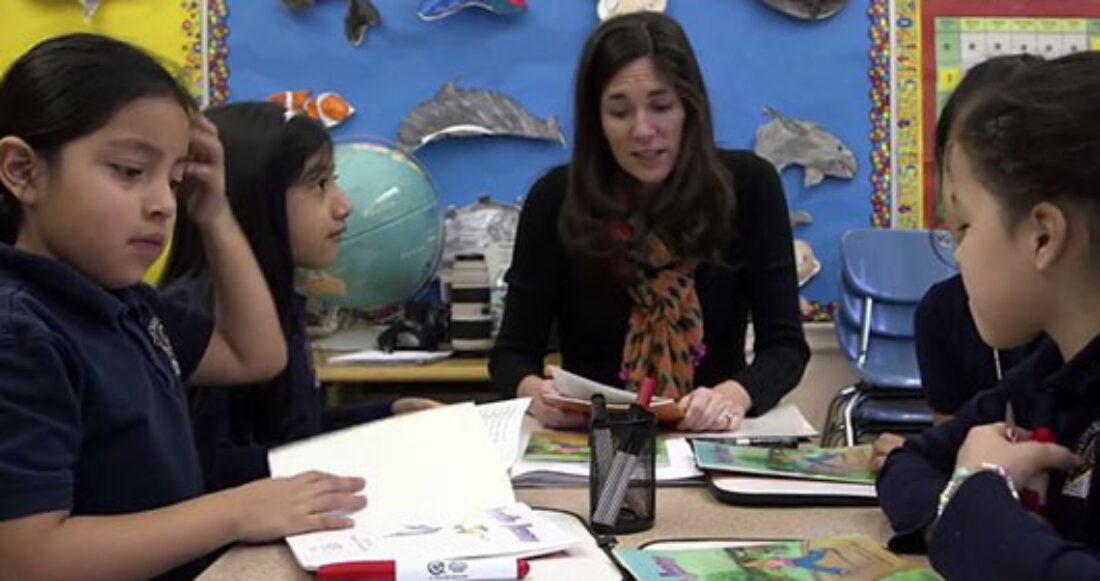Academic Success in Low-Income New Jersey School District Offers National Model

Union City, New Jersey is home to a major success story. Situated just across the Hudson from Times Square, it’s a poor community with an unemployment rate of 60% higher than the national average, where most students are enrolled in the free and reduced lunch program. Ninety percent Latino, three quarters of the students here, mainly recent immigrants, are considered “at risk” because they live in homes where only Spanish is spoken.
In fact, just 25 years ago, Union City’s schools were so bad the state was poised to size control of them. Silvia Abbato, now Union City’s assistant superintendent of schools, was part of the review team at the time. “We started with a universal pre‑K program for the district, which was vital to building a basic educational foundation. By the time they get to kindergarten now, these children are reading.” Abbato, whose parents are Cuban, has worked in the district as a teacher and principal for 34 years.
The educators saw that the class that went through the cohort as preschoolers, when they got to third and fourth grade had outstanding New Jersey scores. “If you want to make changes in the middle school, you have to start in the elementary. If you want to make impact in the high school, you have to start in the middle schools. So it’s all process, and it’s a system within a system, with a shared curriculum throughout the district.
Also important is that most of the teaching staff were not only from the community itself, but had, like Abbato, been in the district for years—a continuity and familiarity unusual in inner city public schools where politics often creates rapid staffing turnovers. Principal Les Hanna, whose parents are Puerto Rican, is herself a product of Union City’s schools and has been working there as a teacher and administrator for 36 years.
“Everyone’s looking for the silver bullet that, you know, you’ll get instant results,” says Hanna about school reform. “But it takes years of work. And it’s years of tweaking and seeing ‘OK, this worked, let’s continue with that and build upon it. This is not working, so let’s scale back.”
Silvia Abbato: “What we started doing was we build from the bottom and the top. And this way you meet in the middle. Some districts are successful in primary, but then when it comes to middle and high school, then that success erodes. So you ned to have an across-the-board pre‑K to twelve vision. It’s a vision that you constantly have to revise, you have to constantly develop, and change constantly. And not to be afraid to say, “We made a mistake, didn’t work, let’s go on.”
The district managed an amazing turnaround: today, the test scores of students in Union City from third grade through high school, match many of New Jersey’s more well-off, and predominantly white, suburban districts. In 2011, 89.5% of the district’s students graduated from high school—roughly ten points higher than the national average. Last year, 75% of Union City graduates enrolled in college, with top students winning scholarships to the Ivy League.
David Kirp, a professor of public policy at U.C. Berkeley Kirp, is convinced that Union City’s transformation offers a model for institutional reform nationwide. “Some argue that our schools are irremediably broken and that charter schools are the only solution,” Kirp told us. “Districts are desperate for the quick fix — the flashiest new curriculum of the moment; closing failing schools; firing teachers who are counting the days ‘til retirement and bringing in inexperienced Teach for America grads. That’s not the approach Union City took — they build, from the bottom up, strong bilingual programs—teaching kids first in their native language then gradually bringing them into English — and a community-based system of support for kids from preschool through high school.”
When we came to film at Union City’s George Washington Elementary, we found a vibrant, positive atmosphere of creativity, support and caring. Principal Les Hanna warmly greeted each child by name as they arrived that morning. “It’s a culture of abrazos—hugs and embraces”—as Kirp put it. “It’s not just in terms of school stuff,” he said. “But the school reaches out to the parents—and some of these face real difficulties in terms of work schedules or immigration status. If a kid is absent for a couple of days, or comes in late, the principal calls the parents to find out what’s going on.”
The corridors were lined with colorful art; science and English projects the students were involved in. We filmed in third and fourth grade classrooms, where the crucial transition is underway where children go from learning a language to using a language to learn other subjects.
Several Casey Foundation studies have shown that fourth graders who are reading proficient are far more likely to graduate from high school and become economically successful. Shockingly, the latest data indicates that nationwide, a massive 80% of low-income fourth graders aren’t proficient. Nationwide, only 19% of Latino fourth graders are proficient in reading English. But in Union City, the numbers are four times higher. “Like any other community with poor families,” notes Kirp, “the kids don’t have a lot of language in their lives. But this is a word-soaked curriculum.”
This blog post and accompanying video were produced by Starfish Media Group and journalist Soledad O’Brien.






